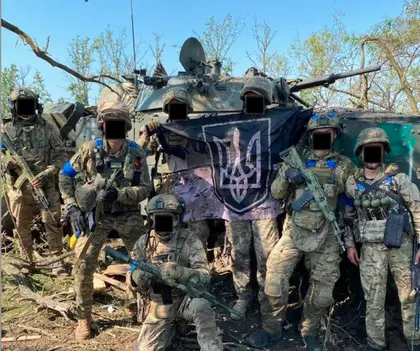The long-awaited Armed Forces of Ukraine (AFU) counteroffensive in its first week has thus far been deliberate and methodical, combining infantry, drones and armored vehicles in targeted assaults of short-range objectives usually no more than one or two wood lines or villages away.
Kyiv’s top military leadership has, to date, followed the conservative strategy of eroding Russian formations over time, gaining ground incrementally, avoiding major risks and limiting Ukrainian casualties as much as possible, independent information sources and Russian military bloggers all agree.
- Examine the most contemporary Ukraine news that came out today.
- Find the latest Ukraine news published as of today.
JOIN US ON TELEGRAM
Follow our coverage of the war on the @Kyivpost_official.
Southward village by village
The village of Storozheve, in the western Donetsk region, was captured by elements of the 35th Marine Brigade on June 11. The Marines prefaced their assault with a punishing artillery bombardment allowing infantry riding in NATO-issue armored cars to drive to the village edge, debus, and then carefully clear the hamlet, in due course putting Russian defenders to flight. Ukrainian casualties were few, a soldier said.
“At first there was heavy fighting, the enemy tried to suppress us with artillery, we were able to take the initiative into our hands, and bit by bit, house by house, we were able to liberate the village,” Marine combat leader “Dos” said in video published on Monday by the unit.
The speaker said Russian troops ended the battle by abandoning equipment, ammunition, weapons and running “for their lives.” Armed Forces of Ukraine (AFU) troops counted “around 50 Russian soldiers killed, and four taken prisoner.”
British Defence Intelligence Update Ukraine 9 January 2025
Other images showed a Russian army Ural truck loaded with ammunition, apparently captured almost intact by the Ukrainians. Marine “Kinder” said: “They [Russian defenders of Storozheve] ran away, they abandoned all their equipment.”
The 35th Marine Brigade’s claim of a local rout of Kremlin troops, following a slow-paced attack designed to keep Ukrainian losses to a minimum, was supported by widely shared, geolocated drone video showing close to 30 Russian soldiers running away at some speed from positions around Storozheve.
The Marine attack on Sunday was, per reports from both sides, another in a series of short, careful Ukrainian steps down the TO518 farm road, paralleled by a minor stream called the Mokri Yaly River, slowly gnawing southward into deeply layered Russian defenses.
On Saturday, according to Ukraine’s Joint Forces South, another capable volunteer unit called the 7th Battalion, 109th Territorial Defense, sieved the village Neskuchne, a slightly bigger dot on the map, just north of Storozheve, in a similar one-day, dawn assault.
Detachments of another light infantry unit, the 68th Jaeger Brigade, captured a village on the other side of the T01518, called Blahodatne, on Sunday, and documented its liberation with a jubilant flag-raising.
Adamantly pro-Russian sources, on Monday, were tacitly admitting that the deliberate Ukrainian tactics were unspectacular but undeniably gaining ground. Russian defenses are under increasing pressure – bad news that some say the Russian top commanders aren’t being told.
Writing of the loss of Neskuchne, Storozhove and Blahodatne, Semyon Pegov, a Donetsk-based “war correspondent,” wrote: “We are receiving scattered information of the persistent advance of the enemy… step by step they are approaching Urozhaine… The thing is, these worrying trends that could make the situation critical in this sector, are continuing to grow. According to [my] sources from the field, too little reporting to the top echelons [of the Russian military] are playing a cruel joke on our troops.”
The next village south along the T0518, Urozhaine, would fall next unless the bosses in Moscow deal with the situation, Pegov warned.
Russian forces attempted to recapture Storozhove on Monday but were ambushed, losing vehicles and prisoners to the Ukrainian marines, according to battle video surfacing during the day.
Failed Leopard assault
Russians in retreat in #Zaporizhzhia from Ukrainian artillery. Unknown exact POS. Foreground shows what is likely destroyed Ukrainian armor. pic.twitter.com/TyUBw6HPGs
— FUNKER530 (@FunkerActual) June 9, 2023
Failed Leopard assault
Even the most ambitious attack launched by the AFU since major fighting began – an apparently failed attempt to breach Russian defenses near the village of Mala Tokmachka and the city of Orikhiv, to the west of Storozhove in Ukraine’s Zaporizhzhia region – on Thursday, was a limited operation designed to breach Russian minefields, rather than the tip of a blitzkrieg-style assault, most reports said.
The setback handed the AFU losses of 2 to 5 German-manufactured Leopard 2 tanks and 4 to 11 US-made Bradley infantry fighting vehicles, according to mixed reports. Few Ukrainian soldiers were hit but the Mala Tokmachka assault, the largest-scale armored attack of Ukraine’s offensive so far, was stopped in its tracks, Ukrainian and Russian sources agreed.
Pro-Russia sources said the attack was, apparently, aimed at plowing paths through Russian minefields and hitting Russian positions in the vicinity with Leopard and Bradley cannon in a nighttime combat engineering operation, rather than smashing through Russian lines and motoring south.
Subsequent drone images published in Russian media and battle video released by the AFU appeared to bear that out, showing multiple mine-clearing vehicle hulks on the battlefield and Bradleys stopped by track hits.
Pro-Russia blogger Vladimir Rogov said that the Ukrainian assault first was hit by Russian artillery, then Russian infantry-launched anti-tank missiles. When the Ukrainians retreated, they found their path to safety had been seeded with Russian artillery-delivered land mines, and vehicles losing tracks to the unexpected minefield were later destroyed by Russian helicopter gunships, Rogov claimed.
Images later published by Russian state media seemed to show gunships hitting vehicles with tracks or road wheels blown off, sitting immobile at a collection point, and waiting for evacuation.
Bakhmut sector
To the east, in the heavily contested Bakhmut sector, Ukrainian specialist infantry units have registered claimed gains, per reports and battlefield video using classic infantry tactics heavy on close-range fighting, deliberate movement and generous use of hand grenades.
The battles fought daily for more than a week, per those reports, typically involve teams of 50 to 80 men backed by armored personnel carriers aiming to cut off a section of the Russian defenses and grab a line of defensive positions one or two farm fields away from where the Ukrainian attack jumped off.
Men from the 1st Battalion 3rd Assault Brigade from June 9 to 11 captured more than 800 meters of ground near the village Berkhivka over the weekend in a series of platoon- and squad-sized assaults, and attacks were continuing, information platforms said.
A spokesman from Joint Forces East confirmed advances of 250 to 750 meters. The Russian source Zaporozhskiy Front claimed the AFU attacks in the Bakhmut sector had failed, but did not offer evidence.
The UNIAN news agency on Saturday published video of an unidentified unit in a recent attack.
Meanwhile, the 3rd Assault individual soldier social media accounts monitored by Kyiv Post have confirmed that the attacks north of Bakhmut took place, were generally successful, captured between two and eight hundred meters of ground, and were launched at night. The AFU troopers captured POWs, weapons, identification documents and ammunition, and suffered limited casualties, they said.
The 3rd Assault Brigade was raised in Kyiv at the outset of the war and has fought almost continuously on practically every sector of the front. By many accounts it is one of the AFU’s best performing light infantry formation
You can also highlight the text and press Ctrl + Enter









